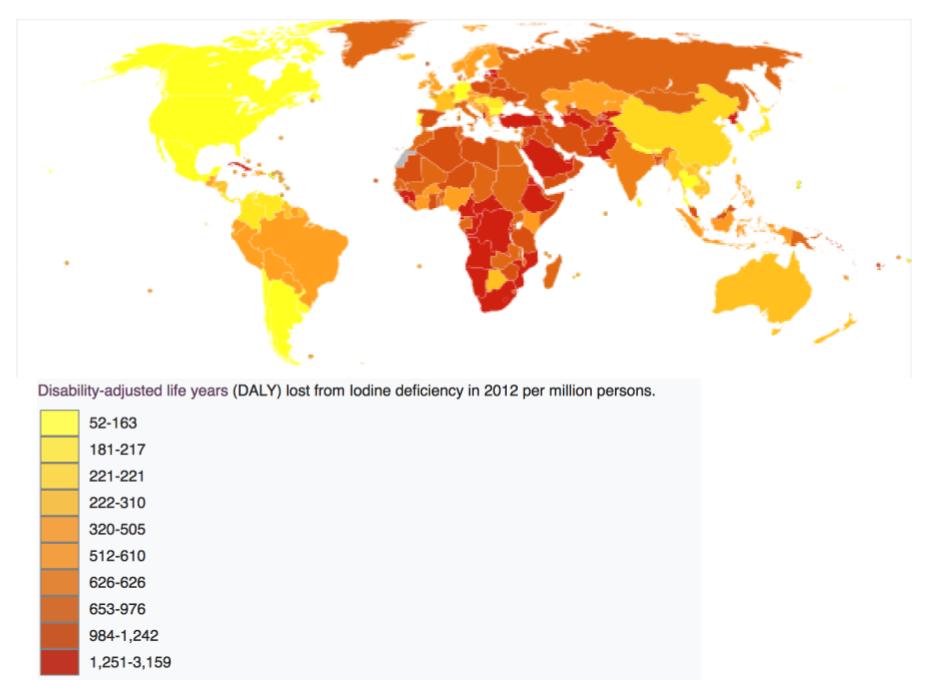Iodine’s Functions In the Body
Recall the discovery of iodine and its use as a means of preventing goiter, a gross enlargement of the thyroid gland in the neck. Iodine is essential for the synthesis of thyroid hormone, which regulates basal metabolism, growth, and development. Low iodine levels and consequently hypothyroidism has many signs and symptoms including fatigue, sensitivity to cold, constipation, weight gain, depression, and dry, itchy skin and paleness. The development of goiter may often be the most visible sign of chronic iodine deficiency, but the consequences of low levels of thyroid hormone can be severe during infancy, childhood, and adolescence as it affects all stages of growth and development. Thyroid hormone plays a major role in brain development and growth and fetuses and infants with severe iodine deficiency develop a condition known as cretinism, in which physical and neurological impairment can be severe. The World Health Organization (WHO) designates iodine deficiency as a global public health crisis, and it is the number-one cause of preventable brain damage worldwide.[1]

(Source: Wikimedia Commons, Chris55, CC-BY-SA)

(Source: Wikimedia Commons, Dr. J.S.Bhandari, India, CC BY-SA 3.0)
Dietary Reference Intakes for Iodine
| Age Group | RDA Males and Females (mcg/day) | UL |
|---|---|---|
| Infants (0–6 months) | 110* | |
| Infants (7–12 months) | 130* | |
| Children (1–3 years) | 90 | 200 |
| Children (4–8 years) | 120 | 300 |
| Children (9–13 years) | 150 | 600 |
| Adolescents (14–18 years) | 150 | 900 |
| Adults (> 19 years) | 150 | 1,100 |
| *denotes Adequate Intake |
Dietary Sources of Iodine
The mineral content of foods is greatly affected by the soil from which it grew, and thus geographic location is the primary determinant of the mineral content of foods. For instance, iodine comes mostly from seawater so the greater the distance from the sea the lesser the iodine content in the soil.
| Food | Serving | Iodine (mcg) | Percent Daily Value |
|---|---|---|---|
| Seaweed | 1 g. | 16 to 2,984 | 11 to 1,989 |
| Cod fish | 3 oz. | 99 | 66 |
| Yogurt, low fat | 8 oz. | 75 | 50 |
| Iodized salt | 1.5 g. | 71 | 47 |
| Milk, reduced fat | 8 oz. | 56 | 37 |
| Ice cream, chocolate | ½ c. | 30 | 20 |
| Egg | 1 large | 24 | 16 |
| Tuna, canned | 3 oz. | 17 | 11 |
| Prunes, dried | 5 prunes | 13 | 9 |
| Banana | 1 medium | 3 | 2 |
Learning Activities
Technology Note: The second edition of the Human Nutrition Open Educational Resource (OER) textbook features interactive learning activities. These activities are available in the web-based textbook and are not in downloadable versions (EPUB, Digital PDF, Print_PDF, or Open Document).
Learning activities may be used across various mobile devices; however, for the best user experience, it is strongly recommended that users complete these activities using a desktop or laptop computer.
- World Health Organization. “Iodine Deficiency.” https://www.who.int/data/nutrition/nlis/info/iodine-deficiency. Accessed July 28, 2025. ↵
- Health Professional Fact Sheet: Iodine. National Institute of Health, Office of Dietary Supplements. https://ods.od.nih.gov/factsheets/Iodine-HealthProfessional/. Updated November 5, 2024. Accessed August 14, 2025. ↵
- Health Professional Fact Sheet: Iodine. National Institute of Health, Office of Dietary Supplements. https://ods.od.nih.gov/factsheets/Iodine-HealthProfessional/. Updated November 5, 2024. Accessed August 14, 2025. ↵
An enlarged thyroid gland caused by a deficiency in iodine.
A gland located in the neck that produces both thyroid hormone and calcitonin.
Hormones that are produced by the thyroid gland and regulate metabolic rate.
The entire biochemical activities of an organism.
A condition that results from poor maternal iodine intake during pregnancy and impairs the mental development and growth of the infant.

